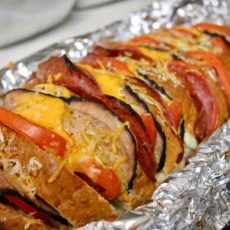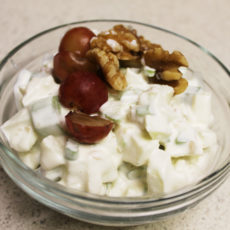Minestrone soup has a few specific memories for me: I remember there always being cans of it in our pantry when I was a kid, and all of my favorite Italian restaurants growing up still have it on the menu. My dad was a big minestrone fan–both of those memories are tied pretty closely to him.
3-6: Minestrone comes from the new book, and it’s not surprising that Simply Delicious had a recipe for it–they tend to have their own versions of most of the “classics”.

I’m not sure I’d suggest serving this in what look like miniature barrels in the picture above (imagine trying to clean those). However, the colder weather is coming soon, and this recipe is a good (and cheap) way to meal-prep, eat your veggies, and stay warm all at the same time.

This is an easy one to adjust if you want to make this vegetarian: just leave out/replace the smoked ham and use veggie bouillon instead. If you want to go further and make it vegan, just make sure you use non-egg noodles and don’t include the suggested Parmesan cheese from the TIPS.

Ingredients. I am making the vegetarian/vegan adjustments I suggested above, but I do that for most of these recipes. I’m swapping the smoked ham for some store-bought seitan strips, and using a vegan “beef” bouillon stock instead. My pasta is from the dollar store, and happens to be in the shape of the alphabet.

Diced up the seitan strips into cube-ish pieces.

I always like to sauté my seitan pieces on their own first to get a bit of color/flavor in the pan.

Now adding in just the onions first, to soften them up a bit.

Veggies continue to be added, probably in the order in which they are being diced/broken down by my off-camera assistant.

Still adding veggies.

After they’ve all sautéed long enough, I move them to the bigger pot as instructed.

Here’s a step that’s not in the recipe–fry or parboil the raw pasta and rice BEFORE adding it to the soup. If you add it in without this step, it will cook out all the starch into the soup liquid and your soup will end up way thicker than you want. If you cook the pasta/rice first (either by parboiling or frying), it will get rid of some of that starch before it gets into your soup.

At the restaurant I worked at, the prep cooks would throw the raw pasta into the deep fryer for a few minutes before adding it to the soup they were making, and when I asked them why, they said they learned that from their moms.
Depending on the recipe and type of pasta, sometimes I fry it, sometimes I boil it. Since this one uses small pasta and rice, I’m going to pan-fry it (like you do with sopa de fideos) since I like the extra bit of flavor that lends to the soup.

Once the pasta and rice is golden brown (like when you make Rice-a-Roni), it’s ready to pull back out of the pan and hold to the side until you’re ready to add it to the soup (at the very end).

After simmering (with pasta and rice added), it’s time for the tomatoes (pre-chopped, because I’m lazy).

Adding in the still-somewhat-frozen peas.

Heating the soup through now that I’ve added everything in.

Final bowl. You can see the difference cooking the noodles first made to the broth when you compare this picture to the final one from 3-20: Italian Tomato Soup. That one had a hint of flour added to it, but I didn’t cook the pasta first (same pasta) and it came out like Spaghetti-Os. This one is definitely much more of a soup.
Grade: A



